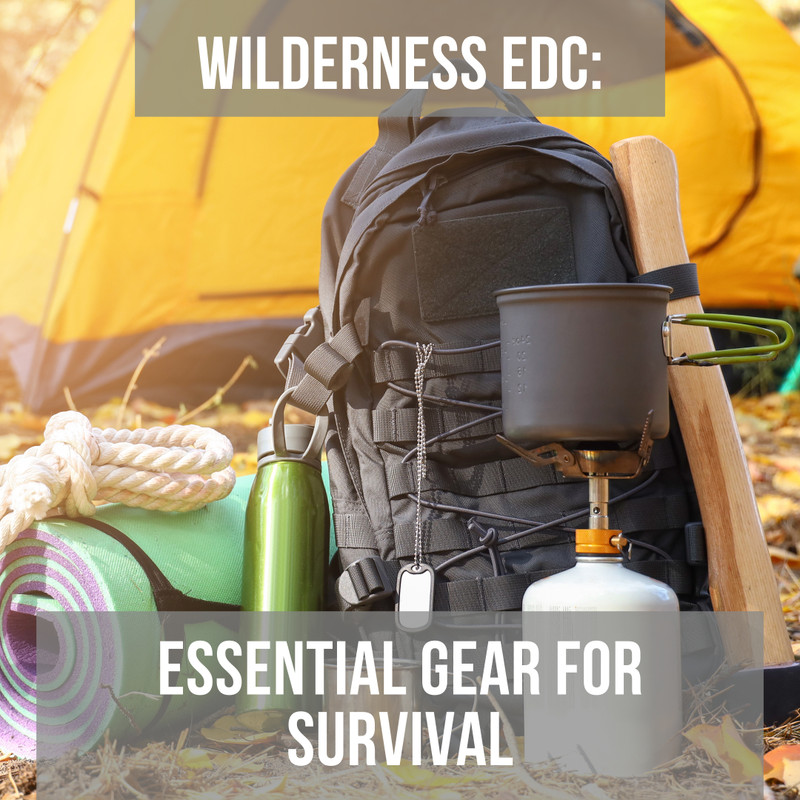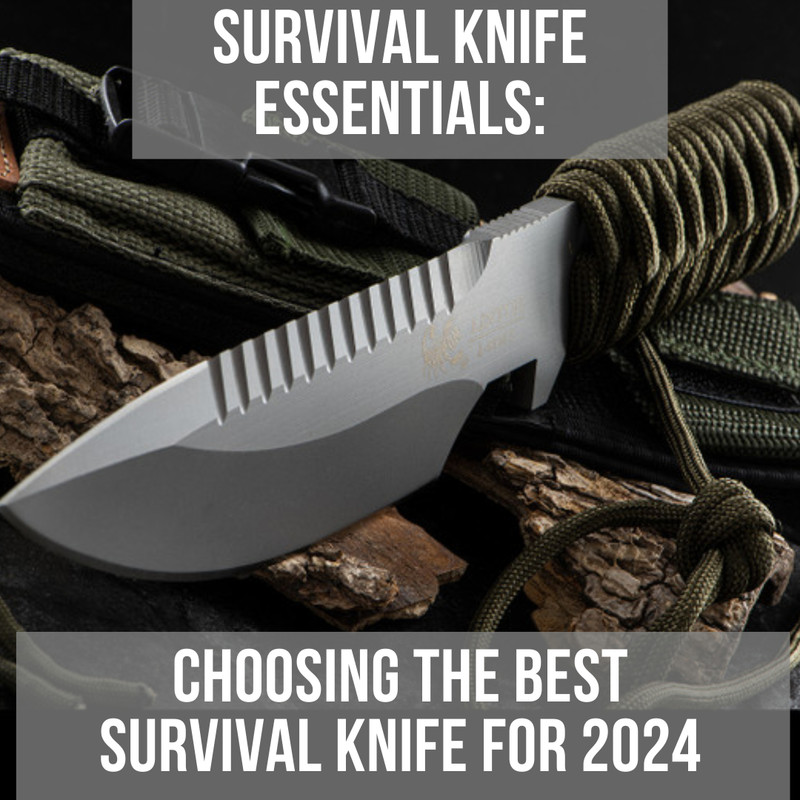Wilderness EDC: Essential Gear for Survival
Posted by HH on 20th Jun 2024
Wilderness EDC, or Everyday Carry, is essential for anyone passionate about wilderness and survival. You carry these items to help you navigate and thrive in outdoor environments.
Having the right gear can make all the difference when you’re miles away from civilisation. Your wilderness EDC kit should include tools like a knife, a fire starter and a compass. Packing a well-thought-out EDC kit equips you for unexpected situations. It’s crucial to carry practical and versatile items.
A good knife can help prepare food, build shelter and provide protection. Similarly, a reliable fire starter is indispensable for warmth and cooking. When selecting your wilderness EDC, strive for a balance between utility and weight. Remember, every ounce counts when you’re trekking through the wild. Consider high-quality multi-tools, lightweight tarps and compact first aid kits.
By choosing the right items, you can increase your comfort and safety while exploring the great outdoors.
The essentials of wilderness EDC
Wilderness EDC (Everyday Carry) involves vital items that help you survive and navigate the wild. These essentials include a reliable knife, fire-starting tools and navigation aids.
Choosing the right knife
A good EDC knife is crucial for bushcraft. It should be robust, durable, and legally permissible for carrying in your area.
Fixed blades are preferred for their robustness, but folding knives can work if chosen carefully.
- Blade material: Stainless steel resists rust but needs sharpening more often. Meanwhile, carbon steel stays sharp longer but is prone to rust.
- Blade length: A 3 to 4-inch blade offers versatility for various tasks, such as cutting wood and preparing food.
- Handle: Ensure a comfortable grip. Materials like rubber or micarta provide good traction.
Explore more options inEDC knives for a range of well-crafted selections.
Fire starting implements
Being able to start a fire is a cornerstone of survival. Fire provides warmth, safety and a means to cook food.
- Ferro rod: A ferro rod is reliable and lasts a long time. Scrape it with the back of your knife to produce sparks.
- Waterproof matches: Useful in wet conditions where other methods might fail.
- Lighter: Easy and quick to use but can be affected by wind and may run out of fuel.
Carrying multiple fire-starting tools prepares you for different scenarios.
Navigational tools essentials

Navigational tools help you find your way in the wild. A good map and compass are non-negotiable items in your EDC kit.
- Compass: An orienteering compass with a baseplate and sighting mirror is ideal for accuracy and durability.
- Map: Topographic maps are the best choice, providing detailed information about the terrain and landmarks.
- Backup: Consider a GPS device or smartphone with offline maps as an electronic backup.
Check your tools regularly to ensure they’re in working order before any trip.
Everyday carry gear for sustenance
Practical everyday carry (EDC) gear can make a big difference in staying nourished and hydrated. This section covers essential items to help you manage food and water needs while out in the wild.
Portable food selection
When choosing portable food for your EDC, focus on items that are long-lasting, nutritious and easy to carry.
Energy bars, dried fruits, and nuts are great options. They provide essential nutrients, are lightweight, and have a long shelf life.
Using vacuum-sealed bags can help protect and preserve food.
Items like jerky and hard cheese are also worth considering due to their durability and energy content.
Always mix carbohydrates, proteins, and fats to maintain energy levels.
Including a small, lightweight stove or portable heater can allow you to cook simple meals.
Compact cookware is also critical for preparing hot food, especially in cold environments.
Water purification methods
Clean water is crucial for survival. Carrying a small water filter is one of the best ways to ensure safe drinking water access.
Several types of filters exist, such as straw filters and pump filters. These are effective at removing bacteria and protozoa.
Alternatively, water purification tablets offer a lightweight and easy-to-carry solution. They are effective against many contaminants and only require a short time to work.
Portable UV purifiers are another option. These devices use ultraviolet light to kill harmful organisms.
They are compact and efficient but require batteries, so always carry spares.
Boiling water remains a reliable method, so include a metal container.
Personal safety and bushcraft
Being prepared for emergencies is vital in bushcraft. Key considerations include having the right emergency signalling equipment and a well-thought-out first aid plan. These tools and skills could be lifesaving.
Emergency signalling equipment
Emergency signalling equipment is essential when engaging in bushcraft. It’s crucial to carry tools to draw attention if you get lost or injured.
A whistle is lightweight, and people can hear it from far away. Meanwhile, a signal mirror can reflect sunlight to catch the attention of searchers.
Emergency strobe lights are helpful in low-light situations.
Carry a brightly coloured bandana or flag to increase your visibility.
Fire-starting tools also help, as people can see smoke from a distance, so ensure you have waterproof matches or a reliable lighter.
Electronic devices like personal locator beacons (PLBs) send distress signals via satellite.
First aid considerations

You should always have a first aid kit for bushcraft in your EDC. This kit should include bandages, antiseptic wipes and pain relievers.
A multi-use knife is crucial for cutting bandages, removing splinters and other medical tasks.
Knowing how to use first aid tools properly can prevent minor injuries from becoming serious problems.
Include a list of emergency contacts and any personal medical information.
Having leaves or plants that can serve as makeshift bandages is helpful, but know which are safe to use.
Remember, your safety gear and training are as crucial as your knife and other bushcraft tools.
Avoid taking unnecessary risks; always let someone know your plans before heading out.
Financial preparedness in the wilderness
When heading into the wilderness, it’s essential to consider your financial needs. Carrying cash securely and having your emergency contact details in order can make a big difference if something unexpected happens.
Carrying cash safely
Keeping cash safe during a bushcraft outing is crucial. You never know when you’ll need it to pay for supplies or services.
First, make sure your wallet is compact and secure. Opt for a waterproof wallet to protect the cash from rain or accidental drops of water.
Consider splitting your cash into different locations.
Keeping some in your wallet and some hidden in your gear can help you avoid losing everything if one stash is lost or stolen.
Belts with hidden pockets are another excellent option for travel safety.
Always keep your EDC items close to you.
Emergency contact information
Having emergency contact information is vital during any outdoor adventure.
Write down significant numbers, including family, friends and emergency services. Don’t rely solely on your phone; have a physical copy.
Place this list in a waterproof container inside your wallet or backpack.
Make sure to brief one or more of your contacts before heading out.
Inform them of your planned route and expected return time. This will ensure that someone will check on you if something goes wrong.
Add any relevant medical information to your contact list if needed.
Lighting and visibility tools
Proper lighting and visibility tools are essential for your wildernessEDC kit. You need reliable options to ensure safety and functionality in various environments and conditions.
Flashlight selection
When choosing a flashlight, look for one that’s durable, water-resistant and has a long battery life.
LED flashlights are a popular choice because they are energy-efficient and bright.
Consider the flashlight’s size and weight. A compact, lightweight design will fit better into your EDC kit without adding unnecessary bulk.
You should also check if the flashlight offers low, medium, high and SOS modes.
Rechargeable flashlights can be a great option as they reduce the need for spare batteries.
Always regularly test your flashlight to ensure it is in good working condition.
Writing and record-keeping
Writing and record-keeping are great for documenting your adventures and making plans. Choosing the right tools can make your experience much more accessible and reliable.
Choosing bushcraft-friendly stationery
When selecting stationery, waterproof notebooks and all-weather pens are essential. These tools ensure your notes remain clear even in rain or damp conditions.
Notebooks: Opt for small, portable notebooks like Rite in the Rain. They have a waterproof coating that protects your writing.
Pens: Use waterproof pens or pencils. Fisher Space Pens, known for writing in extreme conditions, are a good choice.
Organisation: Pack your stationery in a durable pouch to keep everything in order and protected from the elements. A pouch keeps your notes intact and your supplies easily accessible.
Frequently Asked Questions (FAQs)
What are the essential components of a wilderness EDC kit?
A basic EDC kit should include a knife, fire-starting tools, a water filter or purifying tablets, a compact first aid kit and a multi-tool. Each item should be durable and lightweight.
How do you choose the best knife for your EDC?
Select a knife with a full-tang blade made from high-quality steel for more strength and stability. The handle should provide a good grip. Size and weight are also important. The knife should be easy to carry.
What are the top-rated pieces of EDC gear currently available?
Top-rated items include the Morakniv Companion knife, Exotac NanoSTRIKER XL fire starter, and Lifestraw Personal Water Filter. Each is reliable, durable and effective in various bushcraft scenarios.
Which are the most reliable brands for wilderness EDC equipment?
Reliable brands include Morakniv, Gerber, Leatherman, and Exotac. These brands are known for their consistent quality and strong reputations in the bushcraft and outdoor survival communities.
How should one maintain their EDC gear for maximum durability?
Clean and dry your gear regularly after each use to prevent rust and wear. Sharpen knives and tools as needed. Store items in a dry place to avoid moisture damage. Periodically check for signs of wear and replace components as necessary.
What items do I need to have in a beginner’s EDC kit?
For beginners, include a reliable knife, fire striker, whistle, small first aid kit and a lightweight water filter. These basics will cover essential needs. As you gain more experience, you can learn what additional items you require.







